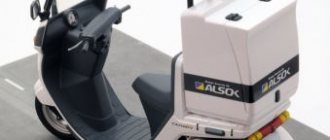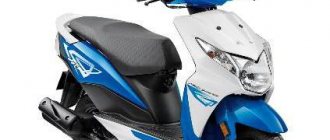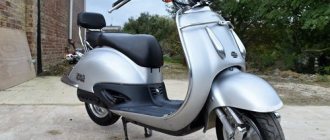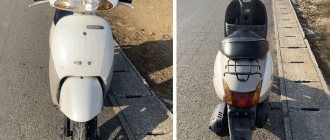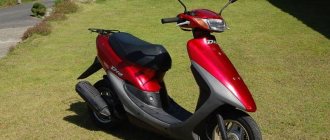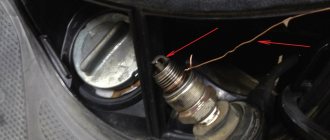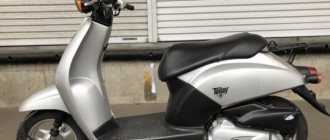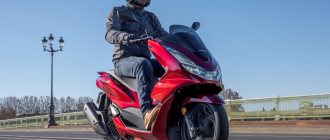Honda Gyro Canopy is a three-wheeled Japanese moped with a roof for transporting goods and people. The scooter is able to protect the driver from precipitation and exposure to negative weather conditions. Widely used for commercial purposes for transporting small luggage (for example, pizza).
Among the advantages of the Honda Guro Kanopy over its analogues are:
- 50 cc engine - reliable, economical, traction;
- The case is larger in volume than most competitors;
- Canopy - adds the ability to operate the scooter in the rain;
- Three wheels increase the stability of the motorcycle.
Appearance
The Honda Gyro Canopy 4T is very different from standard scooters: it is essentially a three-wheeled trike with a roof and a large recess for the trunk. It is equipped with a skew mechanism, in which the engine and rear wheels are located in the rear bogie, and the rest of the body is supported by a movable hinge that tilts when the driver turns the steering wheel.
Three-wheeled scooter Honda Gyro Canopy TA03.
In the front of the scooter you can see krypton light lamps, as well as small rectangular turn signals directly under the windshield. The manufacturer has provided a large wiper with an automatic windshield washer; the wiper only works on ~50% of the entire windshield area.
Honda Guro Kanopi 2008 is equipped with a floating swash mechanism..
The “lobovukha” itself smoothly flows into a plastic half-roof-canopy that protects from wind and light precipitation; it rests on the plastic back of the driver's seat. The ignition switch is located on the driver's right hand on the steering wheel.
Note! The Honda Gyro Canopy is not designed to carry passengers due to its short seat.
Behind the driver, behind the partition, there is a stand for a large luggage box with fastenings. It is perfect for transporting small loads: for example, pizza, which is what it is used for in most cases in Japan.
Load capacity of Honda Gyro Canopy is up to 200 kg.
The trunk is equipped with a lock and a moisture protection function. Above the aluminum rear wheels, slightly smaller in size (8 inches) than the front wheels (12 inches), is a fender with mounts for a license plate. The turn signals and brake light are located in a small strip under the trunk. The muffler is hidden inside.
The Gyro Canopy's dashboard makes it easy to read the fuel level and speedometer.
A small circle-shaped instrument panel is located in front of the driver, it displays a fuel level sensor, speedometer, turn signal and wiper sensor, high beam indicator, and odometer.
Parameters of the Honda Guro Canopy scooter
Dimensional characteristics of the three-wheeled scooter: 1895 mm (length), 660 mm (width), 1690 mm (height). The wheelbase size is 1410 mm, the ground clearance (clearance) is 85 mm. Dry weight – 120 kg, loaded – 139 kg. Load capacity – 200 kg.
Links[edit]
- "The History of BSA Ariel 3". Randolph Automotive. Archived from the original on 2008-03-15. Retrieved March 3, 2008.
- "The History of BSA Ariel 3". Andrew Pattle Moped Archive. Retrieved March 3, 2008.
- "George Wallis Patent". wikipatents.com. Archived from the original on 2008-03-14. Retrieved March 3, 2008.
- "George Wallis Patent". wikipatents.com. Archived from the original on 2008-03-14. Retrieved March 3, 2008.
- "A Timeline of Every Leaned Honda". Honda. Retrieved March 3, 2008.
- "Gyro X Product Page". Honda. Archived from the original on 2008-02-29. Retrieved March 3, 2008.
- "Gyro UP Product Page". Honda. Archived from the original on 2008-02-27. Retrieved March 3, 2008.
- "Gyro Canopy Product Page". Honda. Archived from the original on 2008-02-26. Retrieved March 3, 2008.
- "General Description of Gyro X". Honda. Retrieved March 3, 2008.
- "Gyro X Sales, May 2002". Honda. Retrieved March 3, 2008.
- "Gyro X prices 2008". Honda. Archived from the original on 2008-02-29. Retrieved March 3, 2008.
- "Zoomer 2008 Pricing". Honda. Archived from the original on 2008-01-14. Retrieved March 3, 2008.
- "Acronym Gyro X". Honda. Retrieved March 3, 2008.
- "General Description of the UP 1985 Gyro". Honda. Retrieved March 3, 2008.
- "General Description of the Gyro UP 1991". Honda. Retrieved March 3, 2008.
- "General Description of the Gyro UP 1993". Honda. Retrieved March 3, 2008.
- "General description of the Gyro UP 2000". Honda. Retrieved March 3, 2008.
- "Gyro UP luggage platform". Honda. Archived from the original on 2008-02-27. Retrieved March 3, 2008.
- "General Description of the Gyro Canopy 1990". Honda. Retrieved March 3, 2008.
- "General Description of the Gyro Canopy 1993". Honda. Retrieved March 3, 2008.
- "General Description of the Gyro Canopy 1999". Honda. Retrieved March 3, 2008.
- "General Description of the Gyro Canopy 2002". Honda. Retrieved March 3, 2008.
- "Gyro Canopy Cargo Box". Honda. Archived from the original on 2007-12-12. Retrieved March 3, 2008.
- "Gyro Canopy Sales May 2002" . Honda. Retrieved March 3, 2008.
- ↑
Malone, Joe (July 25, 2022).
"Meet the unsung heroes of the Norfolk Airshow". Eastern Daily Press
. - {{cite web | url = https://www.motorscooterguide.net/Honda/Gyro/Gyro.html%7Ctitle= HONDA GYRO (NN50, TG50)
- "General Description of the 1981 Flow". Honda. Retrieved March 3, 2008.
- "Flow Pricing 1981". Honda. Retrieved March 3, 2008.
- "1981 Super Cub Price". Honda. Retrieved March 3, 2008.
- "General Description of Joy 1983". Honda. Archived from the original on 2008-03-15. Retrieved March 3, 2008.
- "Gyro X 1983 Price". Honda. Retrieved March 3, 2008.
- "Just a general description of 1983". Honda. Retrieved March 3, 2008.
- "General Description of Road Fox 1983". Honda. Retrieved March 3, 2008.
General
- Technical specifications of the Honda Gyro X infobox on this Honda page on 2008-03-01
- Technical specifications of the Honda Gyro UP infobox on this Honda page on 2008-03-01
- Specifications of the Honda Gyro Canopy information block from this Honda page on 2008-03-01
- Technical characteristics of the Honda Stream information block on this page Honda on 2008-03-01
- Technical specifications of the Honda Joy information block on this Honda page on 2008-03-01
- Honda Information Window Specifications Just on this page Honda on 2008-03-01
- Technical characteristics of the Honda Road Fox infobox on this Honda page on 2008-03-01
Specifications of Honda Gyro Canopy
The maximum speed of the three-wheeled scooter from Honda is 60 km/h. Oil tank – 1.2 liters, gas tank – 5.9 liters. Engine starting system – kickstarter and electric starter. Front wheels – 100/100-12 62J, rear wheels – 130/70-8 42L.
Engine TA03E
The trike is equipped with a single-cylinder, four-stroke unit of the TA03E brand with four valves and a fuel injection system.
The electronically controlled fuel injection (PGM-FI) system ensures efficient fuel delivery to the combustion chamber of the four-valve engine. The emission of harmful substances is reduced, the computer controls the injection depending on the speed of movement and atmospheric conditions, and also diagnoses the system.
Engine TA03E 4-stroke, water-cooled.
TA03E has an advanced liquid cooling system and a displacement of 49 cm3. Piston group: cylinder diameter – 38 mm, piston stroke – 44 mm. Torque – 4.4 N*m at 7000 rpm, engine power – 4.6 hp at 7500 rpm. Compression – 15 kg/cm2.
Transmission
The variator (V-MATIC) is responsible for the transmission. The braking system features larger 130mm drum pads at the front and rear.
A lever fork is installed at the front, which protects the scooter from dust and dirt getting inside; it also handles bumps well, but it is not intended for high-speed riding. The rear suspension is a simple monoshock absorber.
Front suspension Gyro Canopy telescopic fork; The rear one is pendulum.
The scooter also has a parking brake, which replaces the center stand for everyday riding. After lifting up a special lever on the left side under the steering wheel, the rear wheels are locked and the scooter remains in an upright position.
Note! The parking brake also works as an anti-theft mechanism, i.e. The lever does not lower when the ignition is off.
The Honda Gyro Canopy parking brake is located under the steering column.
Fuel consumption Honda Gyro Canopy
The Gyro Canopy moped consumes 1.83 liters per 100 km in the urban cycle at a cruising speed of 30 km/h.
- Scooter model – Honda 2BH-TA03;
- Engine – TA03E, 4-stroke, 1-cylinder;
- Power unit volume – 49.9 cm³;
- Cylinder diameter – 38.0 mm;
- Piston stroke – 44.0 mm;
- Compression ratio – 12.0;
- Engine power, (hp/rpm) – 4.6 /7500;
- Torque, (H*m/rpm) – 4.4 /7000;
- Cooling – water;
- Fuel system - injector (PGM-FI);
- Average fuel consumption – 1.83 liters/100 km;
- Gas tank volume – 5.9 liters;
- Oil tank – 1.2 liters;
- Maximum speed – 60 km/h;
- Front brake type – drum;
- Rear brake type: drum;
- Tire size (front/rear) – 100/100-12 62J / 130/70-8 42L;
- Front suspension – telescopic fork;
- Rear suspension – pendulum;
- Transmission – CVT (V-Matic);
- Start type – kickstarter/electric starter;
- Scooter dimensions, (L x W x H) – 1895 x 660 x 1690 mm;
- Wheelbase – 1410 mm;
- Seat height – 700 mm;
- Ground clearance – 85 mm;
- Turning radius – 2.0 m;
- The weight of the scooter is 139 kg.
Related cars[edit]
Honda Stream[edit]
Honda Stream
| Manufacturer | Honda Motor Company |
| Also called | NV50, TB07 |
| Production | 1981–1983 |
| Engine | 49 cc 2-stroke air-cooled |
| Power | 3.8 hp at 6500 rpm |
| Torque | 0.46 kg-m at 5500 rpm |
| Transmission of infection | Continuously variable transmission |
| Tires | 8-3.00-2PR |
| Wheelbase | 1.210 m |
| Dimensions | L: 1.665 m W: 0.570 m H: 0.970 m |
| Seat height | 0.658 m |
| Weight | 74 kg (dry) 79 kg (wet) |
| Fuel tank capacity | 4 l |
| Fuel consumption | 74 km/l @ 30 km/h |
| Turning radius | 1.7 m |
Stream was introduced in November 1981. This is Honda's first tilting three-wheeler and has the basic characteristics of this type. It is a single-seater, scooter-like vehicle with an automatic transmission and a one-push parking brake. It has a small hinged rear end containing a 49cc 2-stroke engine. See and two drive wheels driven through a limited slip differential. The Stream has been designed and priced as a luxury personal scooter. Honda's suggested retail price in 1981 was ¥198,000, compared to ¥114,000 for the 49 cc Super Cub. Unlike the Cub, the Stream can only carry one driver and does not have a luggage rack. The only cargo capacity is a small 5kg nose compartment and a 2kg glovebox. It was discontinued in 1984. [27] [28] [29]
Honda Joy[edit]
Honda Joy
| Manufacturer | Honda Motor Company |
| Also called | NM50 |
| Production | 1983–1984 |
| Engine | TB08E 49 cc, air-cooled, 2-stroke |
| Power | 3.7 hp @ 6000 rpm |
| Torque | 0.47 kg-m at 5000 rpm |
| Weight | 46 kg (dry) |
Joy was introduced in April 1983. It was a significantly less expensive car than the Stream, priced at just ¥99,800. It is a personal vehicle with a small bicycle-style front basket and an equally small rack at the rear. The cargo-oriented Gyro X of the same year was twice as heavy and cost ¥189,000. Joy was discontinued in 1984. [30] [31]
Honda Just [edit]
Honda Just
| Manufacturer | Honda Motor Company |
| Also called | NN50, A-TB09 |
| Production | 1983 |
| Engine | TB08E 49 cc, air-cooled, 2-stroke |
| Power | 3.7 hp @ 6000 rpm |
| Torque | 0.47 kg-m at 5000 rpm |
| Transmission of infection | 2-speed automatic transmission |
| Tires | 2.75-10-2PR / 3.00-8-2PR |
| Dimensions | L: 1.520 m W: 0.620 m H: 0.945 m |
| Weight | 53 kg (dry) 57 kg (wet) |
| Fuel tank capacity | 3.2 l |
| Fuel consumption | 80.0 km/l at 30 km/h |
| Turning radius | 1.5 m |
Just was introduced in May 1983. It's much the same car as its Joy stablemate. It has a slightly more stylish look and was priced at 129,000 yen. Instead of a bicycle-style front basket, it has a glove box behind the foot guard. Production ceased until 1984. [32]
Honda Road Fox[edit]
Honda Road Fox
| Manufacturer | Honda Motor Company |
| Also called | TG50, A-TB10 |
| Production | 1984 |
| Engine | TB08E 49 cc, air-cooled, 2-stroke |
| Power | 4.0 hp @ 6000 rpm |
| Torque | 0.49 kg-m at 5500 rpm |
| Transmission of infection | 2-speed automatic transmission |
| Tires | 3.00-8-2PR / 4.50-6-2PR |
| Dimensions | L: 1.595 m W: 0.605 m H: 0.915 m |
| Weight | 59 kg (dry) 63 kg (wet) |
| Fuel tank capacity | 3.7 l |
| Fuel consumption | 72 km/l @ 30 km/h |
Road Fox was introduced in July 1984. This is a stylistic departure in the series. Scooter-style plastic body panels are not used, and instead the Road Fox has an open tube frame with steep angles, reminiscent of a beach buggy/chopper. It has motorcycle footpegs and no racks. Production ceased until 1985. [33]
Advantages and disadvantages
Advantages:
- Spacious trunk and glove box.
- Bump-absorbing suspension.
- Appearance and attention.
- The canopy protects from dirt and precipitation.
- Eco-friendly and economical engine with PGM-FI system.
- Comfortable and stable ride.
Flaws:
- Maintenance cost.
- Low plastic rigidity.
- Uninformative dashboard with speedometer.
- Short travel suspension.
Comparison of Honda Gyro Canopy and Gyro X
The Honda Gyro X scooter has been produced since 1991, the last modification was in 2022, but if we compare Kanopy and X in one parallel, then we should consider the TD02, produced since 2008.
On the right in the photo is the Honda Gyro Canopy, on the left is the Gyro X.
The Gyro X model is not equipped with a canopy and has significant differences in body dimensions: 1700 mm (length) x 665 mm (width) x 1405 mm (height) - in all three parameters it is smaller, which means it is more suitable for driving between rows in the city. The curb weight of the Gyro X is 26 kg less - 113 kg (versus 139 kg).
Guro X scooter model with a 4-stroke engine.
The models have no differences in engine: the Giro Kanopy and Guro X (both 2009) have the TA03E installed.
Both tricycles from the Honda Guro model are suitable for driving around the city and in dusty countryside, but they will not survive off-road conditions due to the skewing mechanism.
US options[edit]
Two different models of three different colored gyros were imported into the US from 1984 to 1986. [26]
1984 gyro, model NN50[edit]
The Gyro NN50 was introduced in the United States in blue and red. This is the narrow rear track version, with the front end being almost identical to the Honda Spree and the rear being unique to the NN50.
1985-86 Gyro S, model TG50[edit]
The TG50 Gyro S was a lower, wider variant specifically for the US market. It was very close in design to the Road Fox. It was sold only in black in 1985 and only in red in 1986. Imports of the Honda Gyro into the US ceased after 1986.
Honda Gyro Canopy Price
You can buy a Giro on the Russian used market or order it from Japan, but the cost will differ depending on the year of manufacture and the city of delivery. The price for a Honda Guro in Vladivostok to order is about 70-90 thousand rubles per copy in good condition. In Russia, an available scooter will cost at least 55 thousand rubles, excluding delivery throughout the country.
New and used Honda Gyro Canopy scooters can be purchased on the Drom.ru website from dealers and individuals.
How much does it cost and where to buy
The Honda Giro Canopy moped ceased production in 2012, so at the moment you can only purchase a used scooter. The average price range in the city of Moscow depends on the modification of equipment and its technical condition. The average figures are settled in the range from 90 to 120 thousand rubles . Popular banks issue loans for purchases on favorable terms without any problems. Transport companies that cooperate with specialty stores can deliver your purchase to your home.
Prices for a used moped in Ukraine range from 450 to 950 dollars. The purchase can be delivered to your home or by Autolux.
